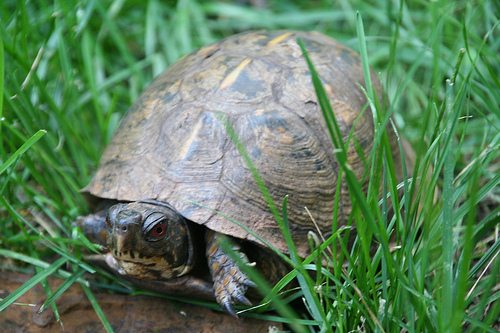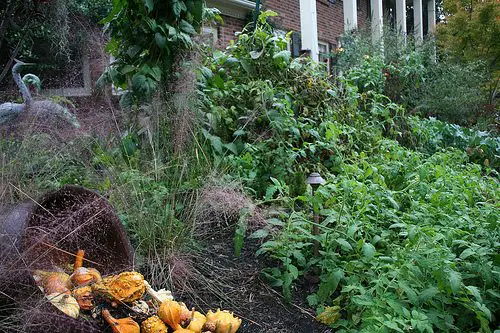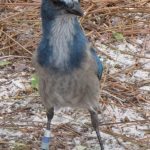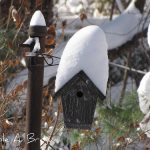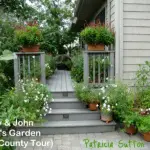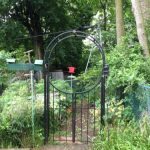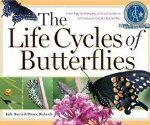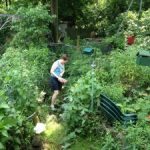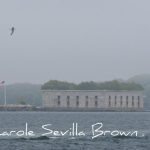(Editor’s note: We have a very special treat in store today. This is a guest post by Helen Yoest of >Gardening with Confidence. Helen Yoest is a garden writer, garden speaker, garden coach, garden scout, garden designer, essentially if it has to do with gardening, Helen is the queen. I’m honored that Helen has chosen to share her fabulous Ecosystem Garden with all of us today. Join us now in this wonderful tour of Helen’s Haven.)
Helen’s Haven
A Wildlife Habitat on a 1/2 Suburban lot
Raleigh, NC
By: Helen Yoest
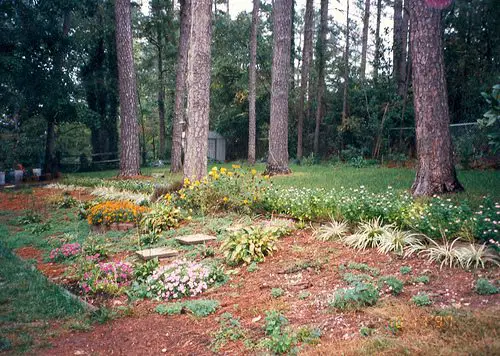
Yard Before (c) Helen Yoest
The birds take flight as I walk down the garden path; otherwise I’m alone. Light is low in the morning hours with scents in the air to attract me and the wildlife.
My garden, Helen’s Haven, in enjoyed by me, my kids, the wildlife. Helen’s Haven was designed with all in mind.
A garden full of color, scent, flower, texture, and wildlife is a way of life for my kids (8, 9, and 13); they don’t know any better. Often, they will ask why other kid’s from school don’t have gardens that are flush with flowers, why they aren’t luring lizards, or chasing fireflies in the cool of the early summer evening. It’s all in a days adventure with the Yoest family; we wouldn’t have it any other way.
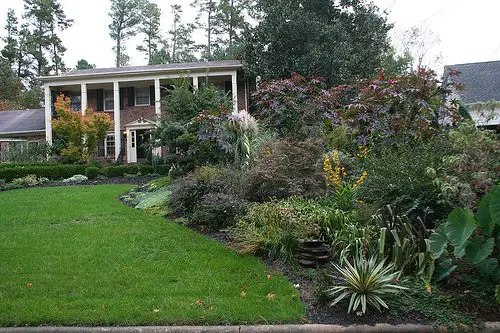
Red Bed From Street (c) Helen Yoest
Helen’s Haven is a certified wildlife habitat by the National Wildlife Federation and a certified Monarch Way Station.
Plants are selected to attract and feed the birds, bees, and butterflies, plus any other critter that has a mind to stay. Helen’ Haven also provides feeding stations, nesting boxes and water.
Many bees are attracted as pollinators, as well as, honey makers. For the butterflies, Helen’s Haven provides dedicated host and nectar gardens filled with specific plants for the butterflies to lay their eggs, to feed larvae, to provide shelter to form chrysalis and to sip nectar as an adult.
To certify as a wildlife habitat, certain requirements were met. A garden must meet food, water, cover, and places to raise young requirements. Here’s some of what we provide:
FOOD: Host, nectar and seed
Abelia, Aster, Azaleas, Candytuft, Cannas, Cleome, Chrysanthemum, Coreopsis, Dianthus, Dogwood, Daylilies, Ginger, Goldenrod, Holly, Juniper, Lantana, Liatris, Milkweed, Mint, Monarda, Oregano, Passion flower, Phlox, Coneflowers, Rudbeckia, Salvias, Sedums, Senna, Shasta Daisy, Verbena, Veronica, Viburnum, Willow, Yarrow, Zinnia
With plenty natural food for the birds, we use supplemental feeders to bring the wildlife to where we can better view them – up close and personal. We have a main station, a “tree”, to hang suet, song bird mix, thistle, and peanuts, a Blue bird “dinner bell” holding meal worms, 2 tray feeders with song bird mix at two different levels, and another feeder with song bird mix. Helen’s Haven also has a rotting fruit station.
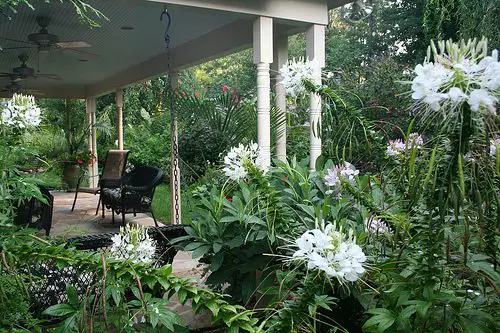
Back Porch Labor Day (c) Helen Yoest
WATER
Running water is provided by a fountain with a relatively large reservoir. Wildlife are attracted to the sound of water. Me too. Frogs live in and around the reservoir and we often hear them jump in as we pass by. We also have 9 birdbaths maintained with fresh water – some low to the ground, others raised. When not in a drought, we mud areas to attract male butterflies to congregate. All the birdbaths have rocks in the bottom so the butterflies can more easily alight.
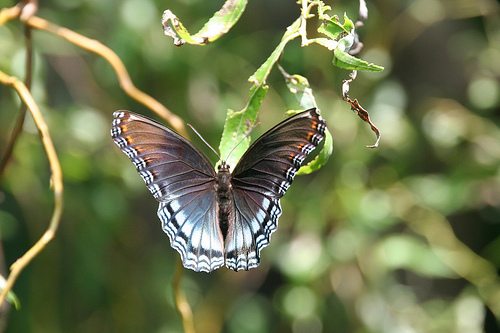
Red-spotted Purple on Weeping Willow (c) Helen Yoest
COVER
We keep the beds lush, but not so much so that they are over-crowded for the butterflies. The gardens are designed with many layers: ground cover, annuals, perennials, shrubs, trees and vines. Each year, we must be careful when we do the winter cut-backs so as not to remove any hiding chrysalis.
PLACES TO RAISE YOUNG
The cover throughout the 1/2 acre property offers plenty of space for the wildlife to make homes. We also maintain 3 bluebird boxes and 5 other nesting boxes.
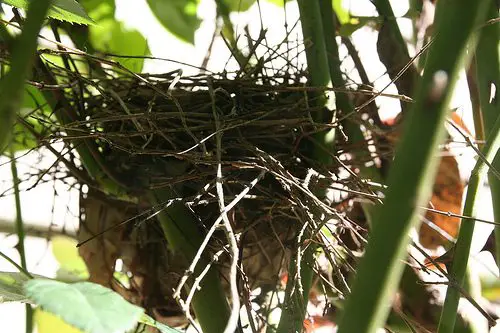
Bird's Nest in Rose Bush (c) Helen Yoest
SOME OF OUR WILDLIFE
| Birds
Cedar Waxwings American Finch Gold Finch Carolina Chickadees Blue Birds Jays Cardinals Crows Hawks Robins Ruby-throated Hummingbirds Brown Towhee towhee Thrushes House sparrow Red-headed woodpecker Mockingbird Wrens Mourning Dove Titmice Downey Woodpecker Screech owl |
Butterflies
Gulf Fritillaries Red Admirals Tiger Swallowtails Black Tiger Swallowtails Monarchs Grey Hair Streaks Azures Skippers Cloudless Sulphurs Red Spotted Purples Cabbage White |
Other Critters
Bunnies – ugh Voles – my nemesis Moles – don’t bother me Mason Bee – yippee Carpenter bee – Get outta here… Honey bees – bring your friends “Hummingbird” moth Dragon flies Frogs – Aster can mimic them exactly Praying mantis Box turtle Spiders And so much more! |
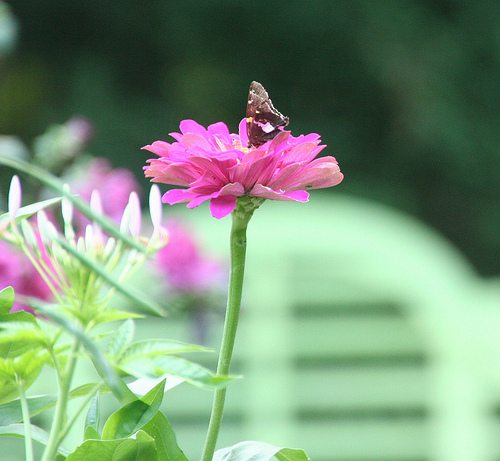
Silver-spotted Skipper on Zinnia (c) Helen Yoest
Stick pile
Each year, we stake out an area to become a stick pile. Lantana, Brugmansia, ornamental grass cuttings, etc., are stacked to give a protective hideout for wildlife. We add other cuttings there, but it is not treated like a compost pile, but ultimately becomes one. Once spring arrives, we start adding any cutting. Each location last 2 -3 years, then we let it compost naturally. We are lucky in that we have a half acre to allow us to do this.
ORGANIC GARDEN
While Helen’s Haven is organic, we don’t think of it in that matter. We just garden in a natural way. Naturally organic. But the buzz word is organic, so organic it is. I’m not fond of the label since it implies there is another way to garden and for us, there isn’t. In other words, we think it is redundant to say we are organic gardeners. We garden for wildlife, ergo, we are organic gardeners.
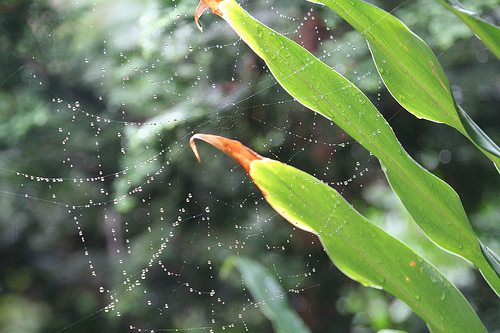
An organic garden, Helen’s Haven uses no chemical pesticides, herbicides, or fungicides. If needed, only organic products are used. Here are some of the many benefits of organic gardening:
- Generally, less work. By letting nature take its natural course, she will keep the good bugs and bad bugs in balance, while also increasing the return of natural wildlife such as birds, frogs and other beneficial species.
- Organic gardens support a wider variety of natural creatures. Allows for a wildlife friendly garden; which in turn, encourages natural wildlife pest controls.
- You can guarantee your food is healthy. For example, our fig tree is brings great joy to my family in the summer. Often times, my children will take a break from their play to have fresh figs. It brings me great joy knowing I don’t have to worry about chemicals.
- Keeps the soil to live. Adding mulch feeds the soil in addition to moderating soil temperature, retains water, suppresses weeds, and gives the beds a finished look. This in turn, helps promote a healthy plant. At Helen’s Haven, we use composted leaf mulch. Composed leaf mulch is replenished on a grand scale annually in the winter and on an as needed basis throughout the year in areas disturbed from adding new plantings and such.
- Fertilizing is done via degradation of the composted leaf mulch. It is not necessary for us to add fertilizers, organic or otherwise.

Veggie Garden (c) Helen Yoest
NATIVES
We plant mostly natives, but have exotics as well. This is a weakness of mine. In either case, we stay clear of invasive plants. Our goal is to include many natives for the wildlife. Natives provide more food, nesting material, and are better to adapt. Also we enjoy new cultivars, we also try to stay with native species. Often times, this is hard to do. We don’t see this as a problem. It is more important to have the right plant in the right place. And to that end, we are true.
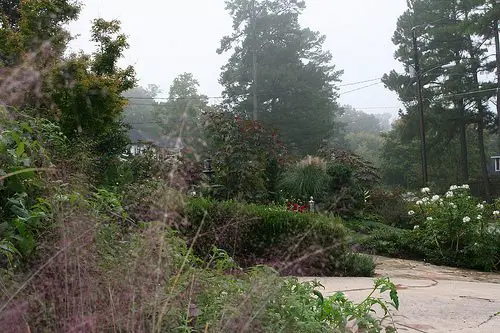
Side View of Front Red Bed (c) Helen Yoest
We believe our garden success is attributed to having the right plant in the right place. It really is that simple. Meeting a plant’s environmental needs such as sun, water, drainage, and air circulation, is the best formula for a successful garden. Helen’s Haven has a pretty, lush, flowery, and wildlife friendly garden that uses less water, no pesticides, fertilizers, herbicides and requires much less time than more conventional gardens.
You must be more patient, though. Organic gardening is a lifestyle change. Once you embrace it, it works beautifully. The results of a beautiful organic garden don’t happen overnight. But everything you do today will benefit tomorrow.
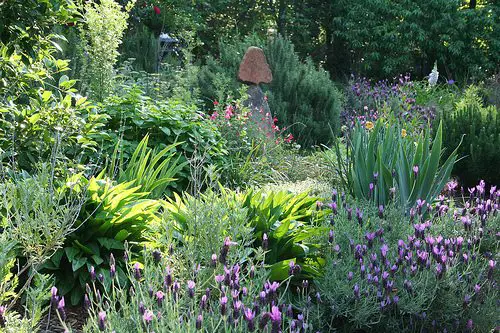
Herb Garden (c) Helen Yoest
I find that I save time and money. When I see a problem, I know that in time it nature will remedy the problem. The less I use, the more this encourages natural wildlife which in turn builds a healthier garden.
WATER WISE GARDEN
A water wise design, Helen’s Haven uses only harvested rainwater collected and stored in two 250 gallon reservoirs and four 80 gallon satellite storage units. With three zones, oasis, transitional and xeric, plants are chosen to flourish in each respective zone. There are also xeric plants in oasis zones and vice versa; however, no special treatment is given to these plants. If, in a given year, nature cares for them, that’s fine, if not, that’s fine as well.
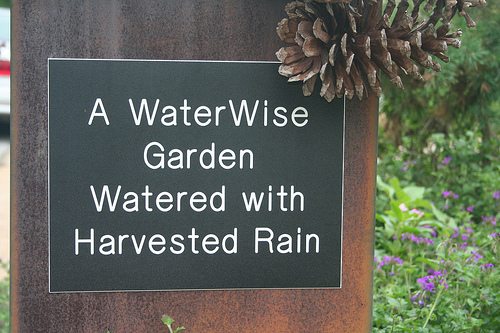
Water Wise Gardening (c) Helen Yoest
The sign on the mail box reads “A Water wise Design, Watered with Harvested Rain.” The tall fescue grass is allowed to go dormant during the absence of rain – affectionally known as going “Dormant for the Moment.”
No water water leaves the property except through the driveway. We are on a slope with a 16 foot drop from back to front. Two series of French drains capture the rainwater and direct to an oasis bed and a rain garden. AC condensate flows into the French drain. The veggie garden (in the front at the top of the driveway) is watered with water diverted from the garage. While we watch our neighbor’s rainwater dump to the street, we take care in capturing every drop. If I could get theirs too, I would.
Our garden is part of our lives. We interact with her daily. She enriches our lives by reminding us how humble we are. We are our small patch of the earth’s care givers, so we are taking care.
More From Ecosystem Gardening:
Submit your review | |

